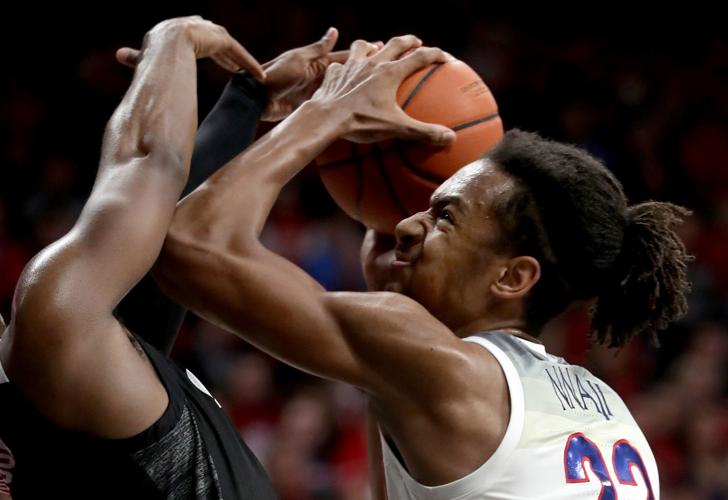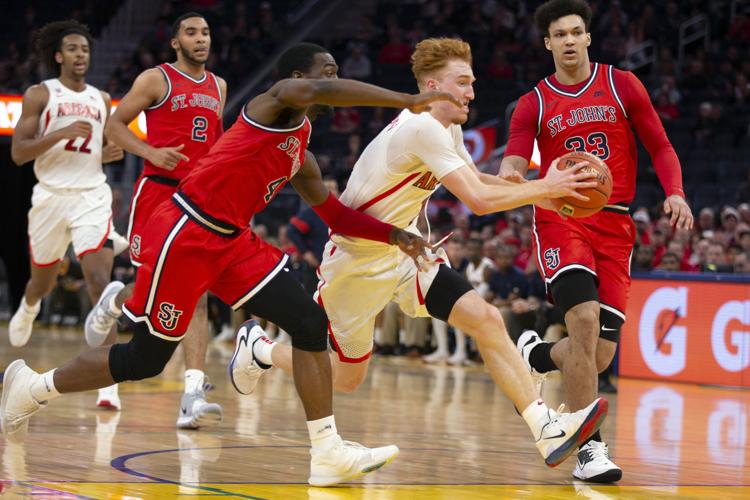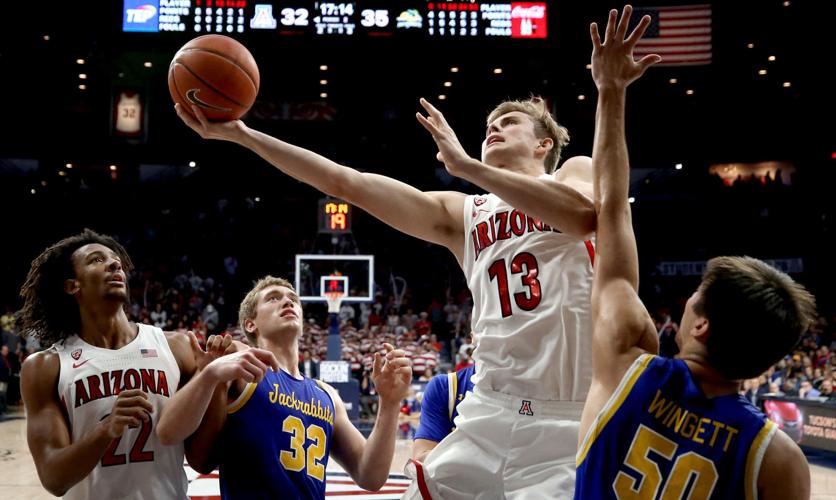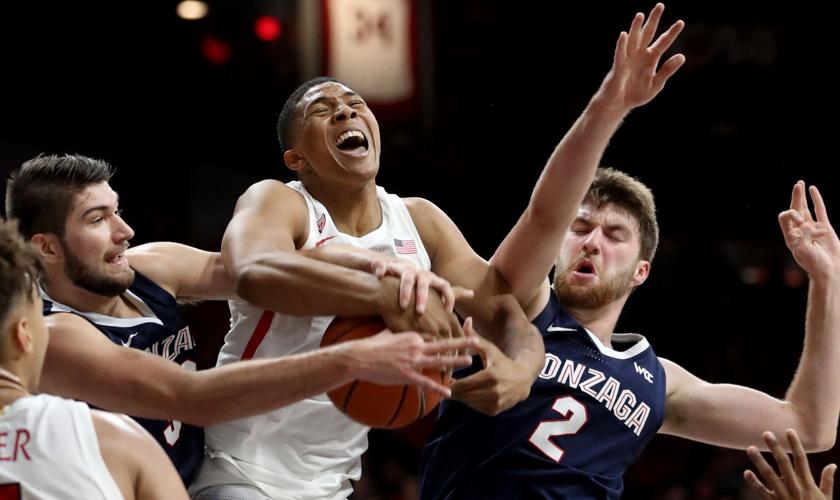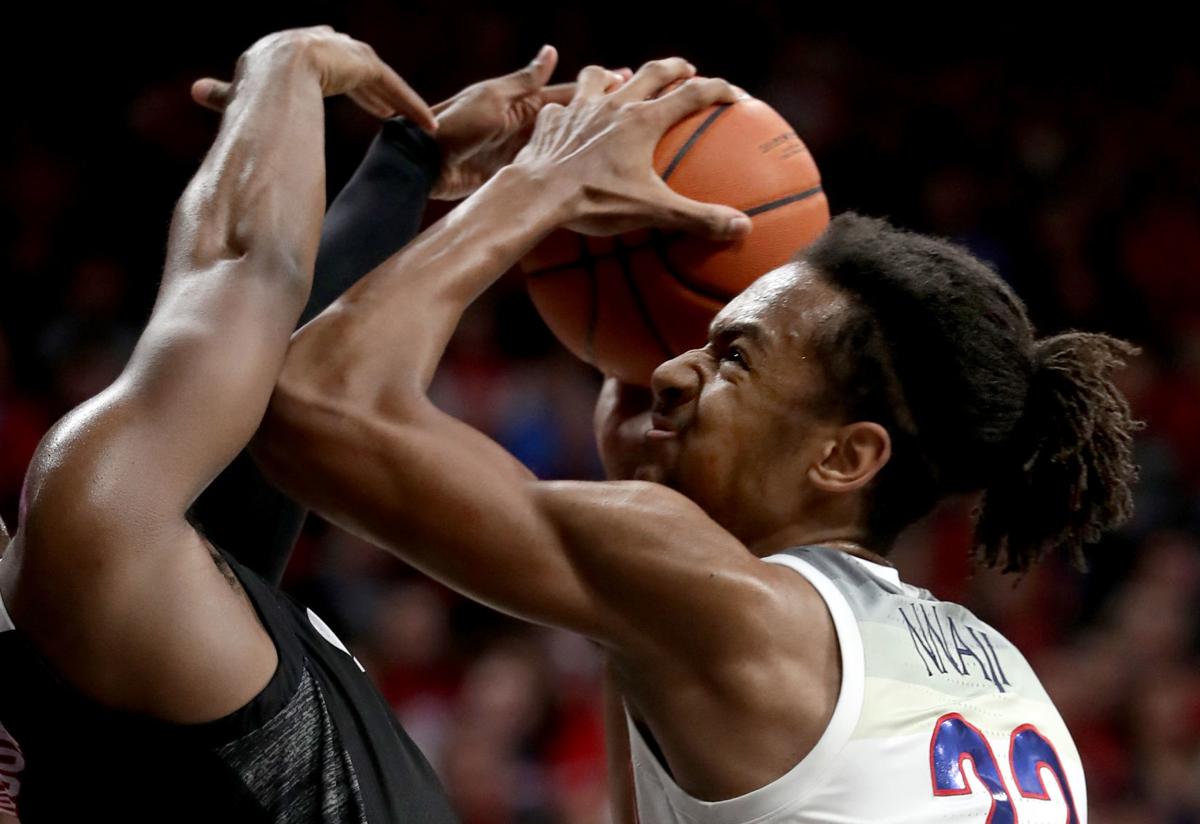By the time the Arizona Wildcats huddled gleefully in the middle of the Anaheim Arena floor to pose with the Wooden Legacy trophy on Dec. 1, their nonconference season had already begun to turn downward.
What was an easy, confidence-building joy ride for Sean Miller’s rebuilt Wildcats through six home victories to start the season pivoted on the night of Nov. 29, when they beat Penn 92-82 in the Wooden Legacy semifinals.
That was the game in which Nico Mannion was 11 for 14 from the field but started experiencing back issues while reserve forward Stone Gettings was whacked in a no-foul collision under the basket, suffering a facial fracture and concussion.
In the five games since then, Gettings has not been able to play at all, Mannion’s shooting stroke has yet to recover, opposing defenses have begun double-teaming efficient freshman Zeke Nnaji inside ... and Arizona has lost three times.
While the Wildcats managed to beat Wake Forest 73-66 to win the Wooden title, with Dylan Smith’s 6-for-9 shooting helping offset Mannion’s 3-of-11 effort, Gettings’ concussion was so severe that he wasn’t able to leave the team hotel.
Later that week, in what was supposed to be a “true” road test, the Wildcats showed up at Baylor to find more than half of the sparse crowd cheering for them, with other Bears fans more interested their school’s efforts at the Big 12 championship football game. Yet the Wildcats still fell behind by 18 and lost 63-58.
After a home-court blowout win against undermanned and undersized Omaha on Dec. 11, the Wildcats charged hard early against now-top-ranked Gonzaga before an initially roaring McKale Center crowd, then fell behind by 16 and lost again.
It was more of the same last Saturday, when the Wildcats played St. John’s in front of a decidedly pro-UA crowd at San Francisco but trailed by up to 16 and lost by three.
Mannion missed four of his five 3s, including a potential game-winner with 30 seconds left, while Smith didn’t play at all after halftime, with Miller steamed over his four first-half turnovers.
Arizona finished nonconference play at 10-3, going 8-1 at McKale Center and 3-2 away from it, despite the fact that Wildcat fans dominated the crowds for all 13 games.
Here’s one look at how some key characteristics developed during the Wildcats’ nonconference season:
1. They played fast ... but sometimes too fast (at least for Miller).
Arizona not only averages 83.7 points but also the 37th shortest time of possession (15.8 seconds) in Division I.
With uptempo minded freshmen guards Mannion and Josh Green leading the way, Miller has said he wants the Wildcats to play quickly but not hastily.
There is a difference, as he often noted.
“You’ve got to be very smart,” Miller said before the St. John’s game. “Just because we’re playing fast, which we want to do, doesn’t mean that we need to be rushed into taking a shot that’s not good for our team.”
This warning came after the Wildcats shot 27% from 3 against Gonzaga, but then they hit just 3 of 16 against St. John’s from long range. Maybe with the NBA 3-point line painted on the Warriors’ home court they were attempting some sort of Steph Curry imitation.
Whatever the case, Miller was not amused.
“During the nonconference season we’ve been able to get away with taking some quick, bad shots,” Miller said after the St. John’s game. “In the first half, we shot insane shots. We might have taken five or six NBA 3s and that speaks to our lack of poise, our lack of confidence at the beginning of the game.”
That came a full month after Miller foresaw the problem leading to losses. During their 71-64 win over South Dakota State at McKale Center on Nov. 21, the Wildcats were just 3 of 17 from 3.
“To take quick, crazy shots, 3-point shots, the way we did tonight?” Miller said after that game. “We’re very fortunate to win.”
2. They took care of the ball when guarded ... but sometimes gave it away.

Arizona’s Nico Mannion drives to the basket against St. John’s. Mannion has struggled from the 3-point line recently, making only 6 of 29 3-pointers in the Wildcats’ last five games.
While Mannion has hit just 6 of 29 3-pointers since that Penn game — with half of those makes coming against Omaha — his assist-to-turnover ratio has actually risen at the same time. Mannion has 36 assists to 12 turnovers since Nov. 29, exactly the 3-1 ratio that’s ideal for a point guard, after having a 2.4-1 ratio over UA’s first eight games. Then there’s Kentucky transfer Jemarl Baker, who has posted a 4.25-1 assist-to-turnover ratio while coming off the bench to play both guard spots.
As a team, UA has the second-lowest offensive steal percentage in Division I, giving up the ball via an opponent’s steal on just 5.9% of its possessions, according to Kenpom.
But the Wildcats’ nonsteal turnover percentage is decidedly mediocre. They rank just 162 out of 353 Division I teams, with an offensive nonsteal turnover percentage of 10.3, suggesting plenty of unforced errors.
That trend was no more visible than it was early in Saturday’s game at San Francisco, when the Wildcats often broke through the St. John’s backcourt press only to fumble or pass it away later in the possession.
“The majority of our turnovers happened in the frontcourt against their pressure, and it took us a while to adjust,” Miller said after the St. John’s game. “As the game chipped away, we became more comfortable but we didn’t come out of the gates playing hard enough.”
Since Miller normally aims for his teams to give up no more than 10 turnovers, there were again plenty of early red flags here. Arizona had 15 or more turnovers in four of its first seven wins.
UA had 16 turnovers in a Nov. 10 win over Illinois and five turnovers over the first eight minutes against South Dakota State, which the UA beat by the thinnest victory margin (seven points) of its initial six-game homestand.
By the time they gave up 16 turnovers that led to 12 Bears second-chance points at Baylor on Dec. 7, the Wildcats had lost their first game of the season.
Smith said Miller made turnovers a “big emphasis” after that game.
“He was like, ‘We’ve got to take care of the ball, and just be more solid on offense and organized,’” Smith said.
In addition, Miller said the Wildcats also had too high a percentage of turnovers that resulted from offensive fouls, especially once Nnaji began having to fight through double teams during the Wooden Legacy.
3. Gettings was the ninth man in the rotation ... but was more important than that.

UA forward Stone Gettings twists his way to a shot against South Dakota State. Gettings missed five games after suffering a concussion against Penn on Nov. 29.
When he was hurt against Penn, Gettings was averaging just 13.5 minutes a game but played a unique role within Miller’s system. Not only was he a shooting threat that defenses had to respect more than UA’s other post players, he was also a crafty and tough offensive force around the basket.
Without Gettings, defenses don’t have to worry about either of UA’s two post players making or even taking perimeter shots — although Nnaji hit one of four 3s he tried over the past five games — while the resulting lack of frontcourt depth meant foul trouble has sometimes forced still-developing freshman Christian Koloko into action.
After Koloko hit 1 of 2 free throws and blocked a shot in six minutes against St. John’s, when Chase Jeter fouled out, Miller said it’s been a challenge mixing him in on a team that already relies heavily on three freshmen.
“With him, that’s four freshmen on the court at the same time, a lot of times, and it’s a lot of inexperience,” he said.
4. The Wildcats average one less foul than their opponents per game ... but still send opponents to the line too often.
In Arizona’s three losses, its opponents have taken four more free throws than the Wildcats have, and if Gonzaga hadn’t missed 13 of its 30 free throws, that Dec. 14 game might have been a double-digit UA loss.
A dive into Kenpom.com helps explain the issue more. The college basketball analytics site says Arizona has the 72nd worst mark for an opponent’s free-throw rate, the ratio of free throws taken to field goals taken, a way to look at how often teams are getting sent to the line within the context of their overall offensive output.
After the Wildcats committed 22 fouls against St. John’s and sent the Red Storm to the line 34 times, Miller said his players have fouled at an “astronomical” level over 13 nonconference games.
“That has to change,” he said.
Miller tried throwing out a 2-3 zone for a handful of possessions against St. John’s to help the problem but found his defense still gave up dribble penetration, which is central to the mission of Miller’s usual pack-line man-to-man defense.
In any case, Miller said the zone is something he’ll have to keep considering for Pac-12 play “considering our foul situation.”
5. They outrebound opponents by an average of 5.8 in wins ... but are being outrebounded in losses by 3.7.

UA’s Ira Lee gets swarmed by Gonzaga defenders during their game last season. This year’s rematch will be postponed, if not canceled.
Some context also makes those figures more alarming.
According to Kenpom.com, the Wildcats rank only 118th in offensive rebounding percentage (30.0) — the amount of times they collect their own missed shots — while they rank in the lower half of all Division I teams by allowing opponents to collect 28% of theirs.
Not surprisingly, this has been a repeated theme in Miller’s news conferences so far this season.
Matt Pile, a 6-foot-8-inch workhorse for Omaha, picked up 12 rebounds against the Wildcats.
Andres Feliz, a 6-2 guard for Illinois, had 10.
A decidedly smaller St. John’s rotation outrebounded UA 40-35 on Saturday and, well, you get the picture.
“Our Achilles’ heel,” Miller said last week, the second time he has characterized rebounding that way. “This is one of the worst rebounding teams that I have had at Arizona.
“We have to get better in that area. I believe we can get better. We have enough talent to improve in that area. But we have to do it.”


